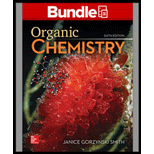
Concept explainers
(a) Give the IUPAC name for A and B. (b) Draw the product formed when A or B is treated with each reagent: 1.
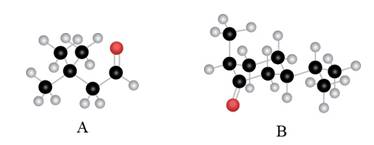
(a)
Interpretation: The IUPAC name for A and B is to be determined.
Concept introduction: IUPAC nomenclature is a systematic way of naming the organic compounds. The basic principles of IUPAC naming for hydrocarbon are:
1. The hydrocarbon is named after the carbon chain containing higher number of carbon atoms.
2. For functional group such as aldehyde suffix ‘al’ and for ketone suffix ‘one’ is added to the name.
3. When the chain is substituted with different substituents, then the numbering is done according to priority.
Answer to Problem 37P
The IUPAC name for A and B is
Explanation of Solution
The given compound is,
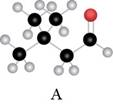
Figure 1
The red coloured balls have two bonds. So, these are the oxygen atoms. Black coloured atoms have four bonds. So, these are the carbon atoms. The grey coloured balls have one bond. So, these are the hydrogen atoms. The molecular structure is,

Figure 2
The parent hydrocarbon is butane. The functional group present is aldehyde. Two methyl groups are present on third carbon atom. When same substituents are present, then prefix depends on the number of substituents. The IUPAC name of the compound is
The given compound is,
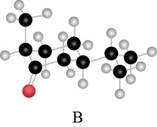
Figure 3
The red coloured balls have two bonds. So, these are the oxygen atoms. Black coloured atoms have four bonds. So, these are the carbon atoms. The grey coloured balls have one bond. So, these are the hydrogen atoms. The molecular structure is,
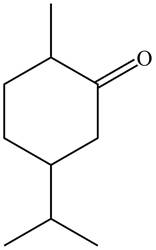
Figure 4
The parent hydrocarbon is cyclohexane. The functional group present is ketone. Methyl group is present on fifth carbon atom and isopropyl group is present on third carbon atom. The IUPAC name of the compound is
The IUPAC name for A and B is
(b)
Interpretation: The products formed when B is treated with given reagents are to be drawn.
Concept introduction: The metal hydride reagents are good reducing agents such as
Grignard reagents are organometallic compounds which are prepared using alkyl halides in presence of magnesium metal in dry ether. These reagents act as strong nucleophiles and bases.
Answer to Problem 37P
The products formed when B is treated with given reagents are,

Explanation of Solution
1. In the presence of
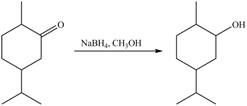
Figure 5
The product formed is
2. The Grignard reagent reacts with compound B to form secondary alcohol. The corresponding reaction is shown below.
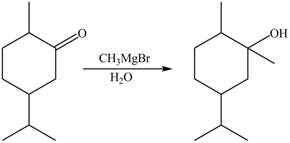
Figure 6
The product formed is
3. When compound B is treated with
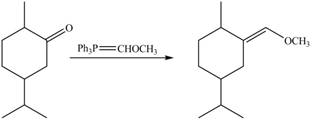
Figure 7
The product formed is
4. The compound B reacts with
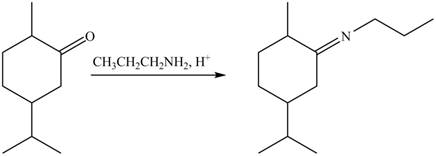
Figure 8
The product formed is
5. The product formed by the reaction of compound B with ethylene glycol in the presence of
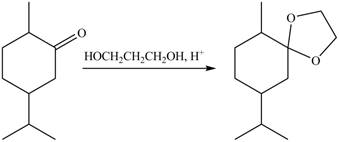
Figure 9
The products formed when B is treated with given reagents are shown in Figure 5, Figure 6, Figure 7, Figure 8 and Figure 9.
Want to see more full solutions like this?
Chapter 18 Solutions
Package: Loose Leaf For Organic Chemistry With Connect Access Card (1 Semester)
- For A,B,C give the IUPAC NAME AND COMMON NAME, while for D,E,F give only the IUPAC NAME.arrow_forwardDraw the organic products formed when cyclopentene is treated withfollowing reagent. Na, NH3arrow_forward2. a. What is the chemical structure of naphthalene, circle functional groups different than alkane,alkene, alkyne? b. Is it polar or nonpolar? _______________________ c. What is its water solubility in g/L? _________________________arrow_forward
- a. What alkane, with molecular formula C5H12, forms only one monochlorinated product when it is heated with Cl2? b. What alkane, with molecular formula C7H16, forms seven monochlorinated products (disregarding stereoisomers) when heated with Cl2?arrow_forward4 Answer the following questions about compound B, represented in the given ball-and-stick model. a. Convert B to a condensed structure and give its IUPAC name. b. What product is formed when B is treated with H 2 in the presence of a metal catalyst? c. What product is formed when B is treated with H 2O in the presence of H 2SO 4? d. What polymer is formed when B is polymerized?arrow_forwardkindi give the IUPAC namearrow_forward
- What happens when (i) chlorobenzene is treated with Cl2/FeCl3,(ii) ethyl chloride is treated with AgNO2, and(iii) 2-bromopentane is treated with alcoholic KOH?arrow_forwardAlkene is converted to alkyl halide by reaction with HCl . (T/F) Iodoform is used as an antiseptic. (T/F) Intermolecular bonding is strongest in alcohols than phenols. (T/F) Formation of blood red colour in Victor Meyer’s test indicated the presence of primary alcohol. (T/F) Fructose is a pentahydroxyketone . (T/F)arrow_forwardGive the IUPAC name for each alkene.arrow_forward
- a. What is the chemical structure of 2,6-dichloroindophenol, circle functional groups differentthan alkane, alkene, alkyne? b. Is it polar or nonpolar? _______________________ c. What is its water solubility in g/L? ___________arrow_forwardGive the IUPAC name for each molecule depicted in the ball-and-stick models.arrow_forward
 ChemistryChemistryISBN:9781305957404Author:Steven S. Zumdahl, Susan A. Zumdahl, Donald J. DeCostePublisher:Cengage Learning
ChemistryChemistryISBN:9781305957404Author:Steven S. Zumdahl, Susan A. Zumdahl, Donald J. DeCostePublisher:Cengage Learning ChemistryChemistryISBN:9781259911156Author:Raymond Chang Dr., Jason Overby ProfessorPublisher:McGraw-Hill Education
ChemistryChemistryISBN:9781259911156Author:Raymond Chang Dr., Jason Overby ProfessorPublisher:McGraw-Hill Education Principles of Instrumental AnalysisChemistryISBN:9781305577213Author:Douglas A. Skoog, F. James Holler, Stanley R. CrouchPublisher:Cengage Learning
Principles of Instrumental AnalysisChemistryISBN:9781305577213Author:Douglas A. Skoog, F. James Holler, Stanley R. CrouchPublisher:Cengage Learning Organic ChemistryChemistryISBN:9780078021558Author:Janice Gorzynski Smith Dr.Publisher:McGraw-Hill Education
Organic ChemistryChemistryISBN:9780078021558Author:Janice Gorzynski Smith Dr.Publisher:McGraw-Hill Education Chemistry: Principles and ReactionsChemistryISBN:9781305079373Author:William L. Masterton, Cecile N. HurleyPublisher:Cengage Learning
Chemistry: Principles and ReactionsChemistryISBN:9781305079373Author:William L. Masterton, Cecile N. HurleyPublisher:Cengage Learning Elementary Principles of Chemical Processes, Bind...ChemistryISBN:9781118431221Author:Richard M. Felder, Ronald W. Rousseau, Lisa G. BullardPublisher:WILEY
Elementary Principles of Chemical Processes, Bind...ChemistryISBN:9781118431221Author:Richard M. Felder, Ronald W. Rousseau, Lisa G. BullardPublisher:WILEY





